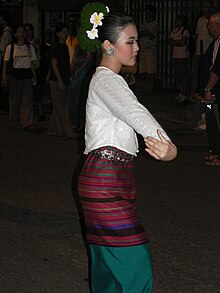ယွမ်လူမျိုး
 ချင်းမိုင်၊အကမယ် | |
| လူဦးရေ စုစုပေါင်း | |
|---|---|
| ၆ သန်း[၁] | |
| အများစု နေထိုင်သည့် နေရာ | |
| ထိုင်းနိုင်ငံ၊ လာအိုနိုင်ငံ (ဘန်ဝေ့ဆိုယ်၊ ဘော့ကဲယ့်မြို့နယ်၊ ဆင်ရာဘူရီခရိုင် နှင့် လွန်းနန်ထာယ်ခရိုင်) | |
| ဘာသာစကား | |
| လန်နား အလယ်ပိုင်းထိုင်းဘာသာစကား | |
| ကိုးကွယ်မှု | |
| ဆက်စပ် တိုင်းရင်းသား အုပ်စုများ | |
| တိုင်းလူမျိုးများ |
ထိုင်းမြောက်ပိုင်းလူမျိုး သို့မဟုတ် တိုင်းယွန်းလူမျိုး (ไทยวน, တမ်းပလိတ်:IPA-nod), self-designation khon mu(e)ang (ฅนเมือง, တမ်းပလိတ်:IPA-nodသည် တိုင်းလူမျိုးအုပ်စုသည်ထိုင်းနိုင်ငံမြောက်ပိုင်းရှိပြည်နယ်ရှစ်ခုတွင်နေထိုင်သည်၊ အဓိကအားဖြင့်ယခင်လန်နားဒေသဖြစ်သည်။[၂] တိုင်းအုပ်စုတစ်ခုအနေဖြင့်သူတို့သည်တိုင်းလူးနှင့်တိုင်းခေးတို့၏ယဉ်ကျေးမှု၊ ဘာသာစကားနှင့်သမိုင်းနှင့်သာမကထိုင်းနိုင်ငံ၏လွှမ်းမိုးထားသည့်ထိုင်းလူမျိုးစုဆိုင်းယန်းနှင့်အလယ်ပိုင်းထိုင်းမျိုးနွယ်စုဟုလည်းခေါ်သည့် ထိုင်းစကားနှင့်အလွန်နီးစပ်သည်။ ခန့်မှန်းခြေအားဖြင့် တိုင်းယွန်းတို့သည်၆ သန်းခန့်ရှိသည်၊ သူတို့အများစုသည်ထိုင်းနိုင်ငံမြောက်ပိုင်းတွင်နေထိုင်ကြပြီး (၂၀၀၅ခုနှစ်လူနည်းစုသန်းခေါင်စာရင်းကောက်ယူမှု) ၂၉,၄၄၂ ယောက်သည် နယ်စပ်ကို ဖြတ်၍ ဘိုကိုပြည်နယ်နှင့်ဆနယာဘူလီနှင့်လာအိုနွမ်သာခရိုင်တွင်နေထိုင်ကြသည်။ သူတို့၏ဘာသာစကားကိုထိုင်းနိုင်ငံမြောက်ပိုင်း၊ လန်းနာသို့မဟုတ်ခမ်းမောင်ဟုခေါ်သည်။
အက်ဆိုးနင်းနှင့်မြိုးရိုးအမည်
[ပြင်ဆင်ရန်]ထိုင်းအလယ်ပိုင်းမြောက်ပိုင်းထိုင်းမျိုးနွယ်နှင့်သူတို့၏ဘာသာစကားကိုယွမ်ဟုခေါ်နိုင်သည်။[၃][၄] အိမ်နီးချင်းမြန်မာနိုင်ငံရှိဗြိတိသျှကိုလိုနီခေတ်မှအုပ်ချုပ်သူများကသူတို့အားရှမ်းလူမျိုးများနှင့်ခွဲခြားရန်သူတို့ကိုထိုင်းနိုင်ငံရှမ်းလူမျိုးများဟုရည်ညွှန်းခဲ့သည်။[၅]
ဤလူမျိုးစုမှလူများသည်သူတို့ကိုယ်သူတို့ ခွန်းမိန်းဟုရည်ညွှန်းကြသည်။ ဆိုလိုသည်မှာ စိုက်ပျိုးမြေမှလူများ၊ “ ငါတို့အသိုင်းအဝိုင်းမှလူများ” သို့မဟုတ်“ လူ့အဖွဲ့အစည်း” ကျယ်ပြန့်သောအဓိပ္ပာယ်ရှိသည့်တိုင်ဘာသာစကားများတွင်အဓိကဘာသာစကားဖြစ်သည်။ တိုင်းလူမျိုး၏လူမှုရေးဖွဲ့စည်းပုံမှာ ဤအမည်ဖြင့်သူတို့သည်သမိုင်းကြောင်းအရမိမိကိုယ်ကိုသွင်ပြင်လက္ခဏာများဖြစ်သောချိုင့်ဝှမ်းများ၊ မြစ်ချောင်းများနှင့်သူတို့နေထိုင်ရာဒေသရှိကုန်းပြင်မြင့်များ၌နေထိုင်ခဲ့ကြသည်၊ ထိုဒေသများသည်ဒေသခံလူထုများနေထိုင်ရာအမ်ဖေးမိန်းဟုခေါ်ပြီးစပါးစိုက်ခင်းများတွင်ဆန်စပါးကိုစိုက်ပျိုးကြသည်။ ဤအချက်ကသူတို့အားဒေသတွင်းရှိဒေသခံများတောင်ပေါ်အနွယ်များနှင့်လူယာလူမျိုးကဲ့သို့ပင်သီးခြားခွဲခြားထားသည့်စိုက်ပျိုးရေးလုပ်ငန်းများမှခွဲခြားထားသည်။ ထို့ကြောင့်လူမျိုးစုဝင်ဖြစ်ခြင်းကိုမျိုးရိုးဗီဇအားဖြင့်မဟုတ်ဘဲလူနေမှုပုံစံစသည့်ပုံစံဖြင့်သတ်မှတ်သည်။ တစ်ချိန်တည်းမှာပင်ဗမာနှင့်ဆိုင်းယန်းလူမျိုးစုများမှခွဲထွက်ခြင်းဟူသောစကားလုံးသည်လန်းနာနိုင်ငံတော်ကိုရာစုနှစ်နှင့်ချီပြီခံယူခဲ့ပြီးသူတို့အမ်ဖေးမိန်းလူမျိုးများမဟုတ်သူများဖြစ်သည်။[၆][၇][၈]
လန်နာကိုထိုင်းနိုင်ငံနှင့်ပေါင်းစည်းပြီးနောက်
[ပြင်ဆင်ရန်]၂၀ ရာစုအစတွင်မြောက်ဒေသပြုပြင်ပြောင်းလဲရေးကာလအတွင်းလနန်ဒေသအနောက်ဘက်မှဖရာ့(มณฑลพายัพ) မှတာဝန်ပေးခဲ့သည်။[၉] ထိုင်းမြောက်ပိုင်းသားများအသုံးပြုခဲ့ဖူးသောတိုင်းသမ်အက္ခရာကိုလည်းလန်နာအက္ခရာဟုလည်းခေါ်သည်။ ဘာသာပြန်ပြုပြင်ပြောင်းလဲမှုများ၏အကျိုးသက်ရောက်မှုများကြောင့်ထိုင်းမြောက်ပိုင်းအနည်းငယ်သည်စာဖတ်ခြင်း၊ ရေးခြင်းများပြုလုပ်နိုင်သည်၊ အဘယ်ကြောင့်ဆိုသော်သူတို့ပြောထားသည့်ပုံစံ၏အတ္ထုပ္ပတ္တိများကိုအတိအကျကိုယ်စားပြုခြင်းမရှိသေးလို့ပါ။
ကြည့်ရှုရန်
[ပြင်ဆင်ရန်]ကိုးကား
[ပြင်ဆင်ရန်]- ↑ Lewis, M. Paul (ed.), 2009. Ethnologue: Languages of the World, Sixteenth edition. Entry for Northern Thai Dallas, Tex.: SIL International.
- ↑ See: Forbes, Andrew, 'The Peoples of Chiang Mai', in: Penth, Hans, and Forbes, Andrew, A Brief History of Lan Na (Chiang Mai City Arts and Cultural Centre, Chiang Mai, 2004), pp. 221-256.
- ↑ Frederic Pain (2008)၊ "An introduction to Thai ethnonymy: examples from Shan and Northern Thai"၊ The Journal of the American Oriental Society
- ↑ Jana Raendchen (10 Oct 2005)။ "The socio-political and administrative organisation of müang in the light of Lao historical manuscripts" (PDF 316 KB)။ in paper 31 (ed.)။ The Literary Heritage of Laos: Preservation, Dissemination and Research Perspectives, Vientiane: National Library of Laos။ The Literary Heritage of Laos Conference, 2005။ Website content written by Harald Hundius and David Wharton, Lao translation by Oudomphone Bounyavong, edited by Harald Hundius.။ Staatsbibliothek zu Berlin Preußischer Kulturbesitz: Digital Library of Lao Manuscripts။ image 4, page 404။ 12 Sep 2013 တွင် ပြန်စစ်ပြီး။
Traditionally, these people called themselves according to the place of their settlement, combining the term "Tai" (man) with the place name, as for example Tai Müang Phuan, Tai Müang Swa (Luang Phabang).
- ↑ Andrew Turton (2004)၊ "Violent Capture of People for Exchange on Karen-Tai borders in the 1830s"၊ Structure of Slavery in Indian Ocean Africa and Asia၊ London: Frank Cass၊ p. 73
- ↑ Andrew Turton (2000)၊ "Introduction"၊ Civility and Savagery: Social Identity in Tai States၊ Richmond, Surrey: Curzon Press၊ p. 11
- ↑ Cholthira Satyawadhna (1990)၊ "A Comparative Study of Structure and Contradiction in the Austro-Asiatic System of the Thai-Yunnan Periphery"၊ in Gehan Wijeyewardene (ed.)၊ Ethnic Groups Across National Boundaries in Mainland Southeast Asia၊ Singapore: Institute of Southeast Asian Studies၊ p. 76၊ ISBN 981-3035-57-9၊
There is a well-known Northern Thai saying: Lua yea' hai The Lua work swiddens Tai het na The Tai work paddy fields.
- ↑ Natnapang Burutphakdee (October 2004)။ Khon Muang Neu Kap Phasa Muang [Attitudes of Northern Thai Youth towards Kammuang and the Lanna Script] (PDF) (M.A. Thesis)။ Presented at 4th National Symposium on Graduate Research, Chiang Mai, Thailand, August 10–11, 2004။ Asst. Prof. Dr. Kirk R. Person, adviser။ Chiang Mai: Payap Universit။ P. 7, digital image 30။ 2013-06-09 တွင် မူရင်း (PDF) အား မော်ကွန်းတင်ပြီး။ 8 Jun 2013 တွင် ပြန်စစ်ပြီး။
The reason why they called this language "Kammuang" is because they used this language in the towns where they lived together, which were surrounded by mountainous areas where there were many hill tribe people.
- ↑ Glenn Slayden:พายัพ (Dictionary)။ Royal Institute Dictionary - 1982။ Thai-language.com (29 Sep 2013)။ 2013-09-29 တွင် ပြန်စစ်ပြီး။ “Royal Institute - 1982 พายัพ /พา-ยับ/ {Sanskrit: วายวฺย ว่า ของวายุ} [นาม] ชื่อทิศตะวันตกเฉียงเหนือ.”
နောက်ထပ်ဖတ်ရန်
[ပြင်ဆင်ရန်]- Andrew Forbes; David Henley (1997)။ Khon Muang: People and Principalities of North Thailand။ Bangkok and Chiang Mai: Teak House Books။
- Volker Grabowsky, ed. (1995)။ Regions and National Integration in Thailand 1892–1992။ Wiesbaden: Harrassowitz Verlag။ ISBN 3-447-03608-7။
- Akiko Iijima (2003)။ The Nyuan in Xayabury and Cross-border Links to Nan။ Contesting Visions of the Lao Past. Laos Historiography at the Crossroads။ Copenhagen: NIAS Press။ pp. 165–180။ ISBN 87-91114-02-0။
- Andrew C. Shahriari (2007)။ Khon Muang Music and Dance Traditions in Northern Thailand။ Chiang Mai: White Lotus။
